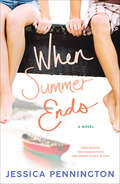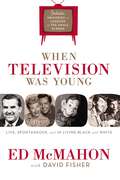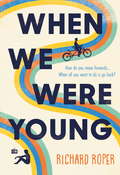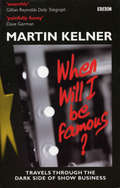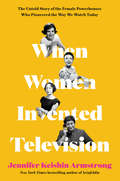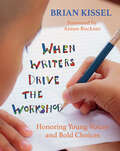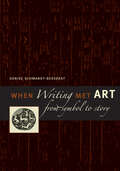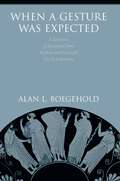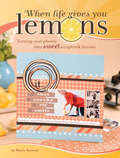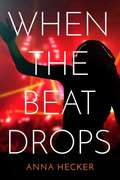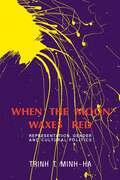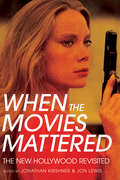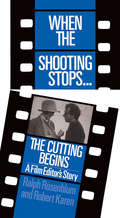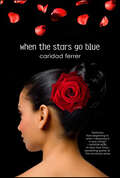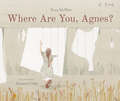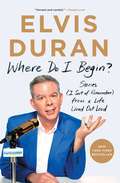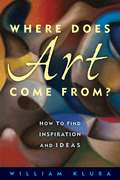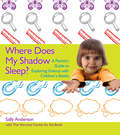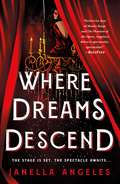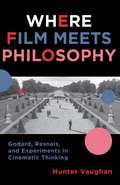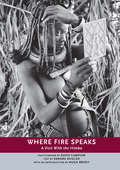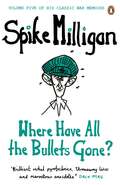- Table View
- List View
When Summer Ends: A Novel
by Jessica PenningtonThree monthsTwo changed fatesOne chance to fall in loveAiden Emerson is an all-star pitcher and the all-around golden boy of Riverton. Or at least he was, before he quit the team the last day of junior year without any explanation. How could he tell people he’s losing his vision at seventeen?Straight-laced Olivia thought she had life all figured out. But when her dream internship falls apart, her estranged mother comes back into her life, and her longtime boyfriend ghosts her right before summer break, she starts to think fate has a weird sense of humor. Each struggling to find a new direction, Aiden and Olivia decide to live summer by chance, letting coin flips, card pulls, and rock, paper, scissors make all the hard decisions. Every fleeting adventure and stolen kiss is as fragile as a coin flip in this heartfelt journey to love and self-discovery from the author of Love Songs & Other Lies.At the Publisher's request, this title is being sold without Digital Rights Management Software (DRM) applied.
When Television Was Young: The Inside Story with Memories by Legends of the Small Screen
by Ed McmahonWhen television was young . . . Legendary movie producer Darryl Zanuck declared, "People will soon get tired of staring at a plywood box every night. Before 5:30, there were only test patterns. Howdy Doody was the first show of the day. CBS agreed to put I Love Lucy on film only if Desi and Lucy paid part of the production fee. In return, CBS gave them ownership of the shows, including the right to rerun it forever. Kukla, Fran, and Ollie was the first network show broadcast in color. 50,000 fans showed up in a New Orleans department store to meet Hopalong Cassidy. Movie studios would not let motion icture stars appear on television for fear that if people saw the stars on TV, they wouldn't go to the movies. Filled with fascinating stories, When Television Was Young is a hilarious, entertaining, behind-the-scenes look at the world of the small screen.
When Was Arts in Health?: A History of the Present
by Frances WilliamsThis book critically appraises the field of Arts in Health in the light of the recent public health crisis and so-called culture wars. A new term was coined in Britain in 2017 for this area of work by an All-Party Parliamentary Group: “creative health”. Williams sets this hopeful assertion against a darker backdrop of austerity, rising inequality and “Covid-nationalism”. Understandings of the field as a (multi)national phenomenon are examined through contested narratives that surround its origin. Using genealogical methods, Williams shows how at supra, national and local policy levels, Arts in Health is presented as an idea that transcends place and time. Arguing against this premise, post-war decades are examined to reveal hidden, mutable arts-health expressions. Examples of practice, and their recognition as such, are context dependent it is concluded – produced by political economies as well as oppositional social movements.
When We Were Young
by Richard Roper'Such a warm, uplifting read. It's a celebration of the bond we have with our oldest friends, and it's so funny' Beth O'Leary'A brilliant, funny, insightful exploration of friendship, which properly made me laugh and cry' Laura Marshall---------Theo has been living in his parents' shed, nursing a broken heart and a wounded ego, convinced life can't get any worse. Then he gets evicted on his 30th birthday. Theo thinks he's done with the real world - until it shows up on his doorstep...Joel is a successful TV scriptwriter, still in love with his teenage sweetheart. A proper grown-up - and yet he's falling apart at the seams. He's headed home to reconnect with best friend Theo - except they haven't spoken since the summer they turned 16.One of them is keeping a secret, and the other is living a lie. But can the promise they once made to walk all 184 miles of the Thames Path help them find their way back to the truth - and to their friendship?A tender and funny story about wanting to go back - when you know it's time to move on.---------'An uplifting and redemptive journey' Steven Rowley'A beautifully bittersweet tale about the enduring power of friendship, reminding us how sometimes the best way to face life's biggest challenges is to take them one step at a time with your best friend by your side' Oliver Sands'An absorbing and heartfelt tale of past mistakes and friendship lost but never forgotten. A joyful summer read' Owen Nicholls---------Your favourite authors loved reading Richard Roper's uplifting first novel, Something to Live For:'A magnificent read. Tender, funny, compelling' Lucy Foley'Funny, moving and thought-provoking - I loved this' Clare Mackintosh'I adored this! It warmed my heart, broke it a little, then put it back together' Beth O'Leary'Funny, fresh and achingly tender. Richard's writing hooked me in from the very first page' Cathy Bramley'A life-affirming novel that simultaneously tweaks your funny-bone and tugs at your heartstrings. Brilliant!' Matt Dunn'It pulls you in, makes you laugh and breaks your heart' Gill Hornby
When Will I Be Famous?
by Martin KelnerWhen Will I Be Famous? is about a world of entertainment; a twilight world far from the bright lights of the West End. Among the pages of Showcall, an annual index of artistes and attractions, there is an army of hopefuls waiting for their big break. Some may be on the verge of a big break; for others, the big break came and went years ago. What they all have in common is that they are out there, entertaining people night after night, folding paper into interesting shapes, telling jokes to businessmen at corporate functions, stripping for hen-parties. Together, they represent an unalloyed triumph of hope over experience. Using acts from Showcall as a starting point, Martin Kelner travels from town to town, demonstrating that how we are entertained, what we do for fun, says at least as much about The Way We Live Now as any other indicator. When Will I Be Famous? is a fascinating and funny account of Britain as seen by the people who try to keep it happy.
When Women Invented Television: The Untold Story of the Female Powerhouses Who Pioneered the Way We Watch Today
by Jennifer Keishin ArmstrongNew and Noteworthy —New York Times Book ReviewMust-Read Book of March —Entertainment WeeklyBest Books of March —HelloGiggles&“Leaps at the throat of television history and takes down the patriarchy with its fervent, inspired prose. When Women Invented Television offers proof that what we watch is a reflection of who we are as a people.&” —Nathalia Holt, New York Times–bestselling author of Rise of the Rocket GirlsNew York Times–bestselling author of Seinfeldia Jennifer Keishin Armstrong tells the little-known story of four trailblazing women in the early days of television who laid the foundation of the industry we know today. It was the Golden Age of Radio and powerful men were making millions in advertising dollars reaching thousands of listeners every day. When television arrived, few radio moguls were interested in the upstart industry and its tiny production budgets, and expensive television sets were out of reach for most families. But four women—each an independent visionary—saw an opportunity and carved their own paths, and in so doing invented the way we watch tv today. Irna Phillips turned real-life tragedy into daytime serials featuring female dominated casts. Gertrude Berg turned her radio show into a Jewish family comedy that spawned a play, a musical, an advice column, a line of house dresses, and other products. Hazel Scott, already a renowned musician, was the first African American to host a national evening variety program. Betty White became a daytime talk show fan favorite and one of the first women to produce, write, and star in her own show. Together, their stories chronicle a forgotten chapter in the history of television and popular culture. But as the medium became more popular—and lucrative—in the wake of World War II, the House Un-American Activities Committee arose to threaten entertainers, blacklisting many as communist sympathizers. As politics, sexism, racism, anti-Semitism, and money collided, the women who invented television found themselves fighting from the margins, as men took control. But these women were true survivors who never gave up—and thus their legacies remain with us in our television-dominated era. It's time we reclaimed their forgotten histories and the work they did to pioneer the medium that now rules our lives. This amazing and heartbreaking history, illustrated with photos, tells it all for the first time.
When Women Ran Fifth Avenue: Glamour and Power at the Dawn of American Fashion
by Julie SatowNEW YORK TIMES BESTSELLER • A glittering portrait of the golden age of American department stores and of three visionary women who led them, from the award-winning author of The Plaza.A BEST BOOK OF THE YEAR: Vogue, Smithsonian, New York Post, and Financial Times"Ms. Satow&’s carefully researched book is compulsively readable: I found myself dashing through it like a novel. She portrays the women with verve; we get a glimpse into their lives, as well as a sense of what it was like at each of these retail meccas." —The Wall Street JournalThe twentieth century American department store: a palace of consumption where every wish could be met under one roof – afternoon tea, a stroll through the latest fashions, a wedding (or funeral) planned. It was a place where women, shopper and shopgirl alike, could stake out a newfound independence. Whether in New York or Chicago or on Main Street, USA, men owned the buildings, but inside, women ruled.In this hothouse atmosphere, three women rose to the top. In the 1930s, Hortense Odlum of Bonwit Teller came to her husband's department store as a housewife tasked with attracting more shoppers like herself, and wound up running the company. Dorothy Shaver of Lord & Taylor championed American designers during World War II--before which US fashions were almost exclusively Parisian copies--becoming the first businesswoman to earn a $1 million salary. And in the 1960s Geraldine Stutz of Henri Bendel re-invented the look of the modern department store. With a preternatural sense for trends, she inspired a devoted following of ultra-chic shoppers as well as decades of copycats.In When Women Ran Fifth Avenue, journalist Julie Satow draws back the curtain on three visionaries who took great risks, forging new paths for the women who followed in their footsteps. This stylish account, rich with personal drama and trade secrets, captures the department store in all its glitz, decadence, and fun, and showcases the women who made that beautifully curated world go round.
When Writers Drive the Workshop: Honoring Young Voices and Bold Choices
by Brian KisselWith increasing school mandates and pressure to perform well on standardized tests, writing instruction has shifted to more accountability, taking the focus away from the writer. In his engaging book, When Writers Drive the Workshop: Honoring Young Voices and Bold Choices , author Brian Kissel asks teachers to go back to the roots of the writing workshop and let the students lead the conference. What happens when students, not tests, determine what they learned through reflection and self-evaluation?In When Writers Drive the Workshop, you'll find practical ideas, guiding beliefs, FAQs, and Digital Diversions to help visualize digital possibilities in the classroom. Written in an engaging, teacher-to-teacher style, this book focuses on four key components of writing workshop: Student-led conferring sessions where the teachers are the listenersThe Author's Chair-, where students set the agenda and gather feedbackStructured reflection time for students to set goals and expectations for themselvesMini lessons that allow for detours based on students' needs, not teacher or curricula goalsAll students have the powerful, shared need to be heard; when they choose their writing topics, they can see their lives unfold on the page. Teachers are educated by the bold choices of these young voices.
When Writing Met Art: From Symbol to Story
by Denise Schmandt-BesseratAn archaeologist and art historian examines the impact of literacy on visual art during the early urban period in the Near East. Denise Schmandt-Besserat opened a new chapter in the history of literacy when she demonstrated that the cuneiform script invented in the ancient Near East in the late fourth millennium BC—the world's oldest known system of writing—derived from an archaic counting device. Her discovery, was published in Before Writing: From Counting to Cuneiform and How Writing Came About, which was named by American Scientist as one of the &“100 or so Books that shaped a Century of Science.&” In When Writing Met Art, Schmandt-Besserat expands her history of writing into the visual realm. Using examples of ancient Near Eastern writing and masterpieces of art, she shows that between 3500 and 3000 BC the conventions of writing—everything from its linear organization to its semantic use of the form, size, order, and placement of signs—spread to the making of art, resulting in artworks that presented complex visual narratives in place of the repetitive motifs found on preliterate art objects. Schmandt-Besserat then demonstrates art's reciprocal impact on the development of writing. She shows how, beginning in 2700-2600 BC, the inclusion of inscriptions on funerary and votive art objects emancipated writing from its original accounting function. To fulfill its new role, writing evolved to replicate speech; this made it possible to compile, organize, and synthesize unlimited amounts of information. Schmandt-Besserat&’s pioneering investigation documents a turning point in human history, when two of our most fundamental information media reciprocally multiplied their capacities to communicate. When writing met art, literate civilization was born.
When a Gesture Was Expected: A Selection of Examples from Archaic and Classical Greek Literature
by Alan L. BoegeholdA boldly innovative study of nonverbal communication in the poetry and prose of Hellenic antiquityWhen a Gesture Was Expected encourages a deeper appreciation of ancient Greek poetry and prose by showing where a nod of the head or a wave of the hand can complete meaning in epic poetry and in tragedy, comedy, oratory, and in works of history and philosophy. All these works anticipated performing readers, and, as a result, they included prompts, places where a gesture could complete a sentence or amplify or comment on the written words. In this radical and highly accessible book, Alan Boegehold urges all readers to supplement the traditional avenues of classical philology with an awareness of the uses of nonverbal communication in Hellenic antiquity. This additional resource helps to explain some persistently confusing syntaxes and to make translations more accurate. It also imparts a living breath to these immortal texts.Where part of a work appears to be missing, or the syntax is irregular, or the words seem contradictory or perverse—without evidence of copyists' errors or physical damage—an ancient author may have been assuming that a performing reader would make the necessary clarifying gesture. Boegehold offers analyses of many such instances in selected passages ranging from Homer to Aeschylus to Plato. He also presents a review of sources of information about such gestures in antiquity as well as thirty illustrations, some documenting millennia-long continuities in nonverbal communication.
When life gives you lemons: Turning Sour Photos Into Sweet Scrapbook Layouts
by Sherry StevesonHonor your sweetest memories - even with sour photos! We all find ourselves with a lemon or two - you know, those photos you get when the lighting is bad or your child runs out of the frame. And when they happen to be your only images of an important event or a special memory, that's when things get really sour. It may be impossible to perfectly capture every moment, but that doesn't mean you can't turn flawed photos into fabulous layouts. When Life Gives You Lemonsshows you how to: Use embellishments, transparencies and journaling to disguise photo flaws and minimize distracting backgrounds. Work with blurry, cut-off or poorly framed photos to enhance the theme of a page. Infuse page designs with energy to draw the eye away from imperfections. Edit your images in Photoshop Elements to correct color, remove glare, convert photos to black and white and more. Life doesn't have do-overs, but withWhen Life Gives You Lemonsas your guide, you won't need them! Bring your most perfect memories to life on the page - less-than perfect photos and all.
When the Beat Drops
by Anna HeckerIt's time to face the music.Seventeen-year-old Mira has always danced to her own beat. A music prodigy in a family of athletes, she'd rather play trumpet than play ball—and with her audition to a prestigious jazz conservatory just around the corner (and her two best friends at music camp without her), she plans to spend the summer focused on jazz and nothing else. She only goes to the warehouse party in a last-ditch effort to bond with her older sister. Instead, she falls in love with dance music, DJing... and Derek, a gorgeous promoter who thinks he can make her a star. Suddenly, trumpet practice and old friendships are taking a back seat to packed dance floors and sun-soaked music festivals, outsized personalities and endless beats. But when a devastating tragedy plunges her golden summer into darkness, Mira discovers just how little she knows about her new boyfriend, her old friends, and even her own sister. Music brought them together. Will it also tear them apart?
When the Moon Waxes Red: Representation, Gender and Cultural Politics
by Trinh T. Minh-haIn this new collection of her provocative essays on Third World art and culture, Trinh Minh-ha offers new challenges to Western regimes of knowledge. Bringing to her subjects an acute sense of the many meanings of the marginal, she examines topics such as Asian and African texts, the theories of Barthes, questions of spectatorship, the enigmas of art, and the perils of anthropology. When the Moon Waxes Red is an extended argument against reductive analyses, even those that appear politically adroit. The multiply-hyphenated peoples of color are not simply placed in a duality between two cultural heritages; throughout, Trinh describes the predicament of having to live "a difference that has no name and too many names already." She argues for multicultural revision of knowledge so that a new politics can transform reality rather than merely ideologize it. By rewriting the always emerging, already distorted place of struggle, such work seeks to "beat the master at his own game."
When the Movies Mattered: The New Hollywood Revisited
by Jonathan Kirshner Jon LewisIn When the Movies Mattered Jonathan Kirshner and Jon Lewis gather a remarkable collection of authors to revisit the unique era in American cinema that was New Hollywood. Ten eminent contributors, some of whom wrote about the New Hollywood movement as it unfolded across the 1960s and 1970s, assess the convergence of film-industry developments and momentous social and political changes that created a new type of commercial film that reflected those revolutionary influences in American life. Even as New Hollywood first took shape, film industry insiders and commentators alike realized its significance. At the time, Pauline Kael compared the New Hollywood to the "tangled, bitter flowering of American letters in the 1850s" and David Thomson dubbed the era "the decade when movies mattered." Thomson's words provide the impetus for this volume in which a cohort of seasoned film critics and scholars who came of age watching the movies of this era reflect upon and reconsider this golden age in American filmmaking.Contributors: Molly Haskell, Heather Hendershot, J. Hoberman, George Kouvaros, Phillip Lopate, Robert Pippin, David Sterritt, David Thomson
When the Shooting Stops . . .The Cutting Begins: A Film Editor's Story
by Robert Karen Ralph RosenblumThe story of one of the most important and least-understood jobs in moviemaking?film editing?is here told by one of the wizards, Ralph Rosenblum, whose credentials include six Woody Allen films, as we
When the Stars Go Blue: A Novel
by Caridad FerrerWinner of an International Latino Book Award, When the Stars Go Blue is a contemporary interpretation of Bizet's Carmen in which the fiery gypsy is reinvented as a modern-day dancer, torn between the attentions of an intense, disciplined music prodigy and a flamboyant soccer player.Dance is Soledad Reyes's life. About to graduate from Miami's Biscayne High School for the Performing Arts, she plans on spending her last summer at home teaching in a dance studio, saving money, and eventually auditioning for dance companies. That is, until fate intervenes in the form of fellow student Jonathan Crandall who has what sounds like an outrageous proposition: Forget teaching. Why not spend the summer performing in the intense environment of the competitive drum and bugle corps? The corps is going to be performing Carmen, and the opportunity to portray the character of the sultry gypsy proves too tempting for Soledad to pass up, as well as the opportunity to spend more time with Jonathan, who intrigues her in a way no boy ever has before. But in an uncanny echo of the story they perform every evening, an unexpected competitor for Soledad's affections appears: Taz, a member of an all-star Spanish soccer team. One explosive encounter later Soledad finds not only her relationship with Jonathan threatened, but her entire future as a professional dancer.
Where Are You, Agnes?
by Tessa McWattThis stunning picture-book imagining of artist Agnes Martin’s childhood gives readers a glimpse into the life and work of one of the most esteemed abstract painters of the twentieth century. Agnes Martin was born on the Canadian prairies in the early twentieth century. In this imagining of her childhood from acclaimed author Tessa McWatt, Agnes spends her days surrounded by wheat fields, where her grandfather encourages her to draw what she sees and feels around her: the straight horizon, the feeling of the sun, the movement of birds’ wings and the shapes she sees in the wheat. One day, Agnes’s family moves to a house in a big city. The straight horizon and wheat fields are gone, but Agnes continues to draw what she sees and feels around her. No one except her grandfather understands what she is trying to capture — not her mother, who asks, “Where are you, Agnes?” when she sees her daughter engrossed in her drawing; nor her siblings, who think her art is ugly. Still, Agnes keeps trying to capture what she sees inside her mind. Agnes Martin grew up to become a famous abstract expressionist artist. Tessa McWatt has written a beautiful story of Agnes’s childhood and how it might have shaped her adult work. Zuzanna Celej’s watercolors adeptly capture Agnes’s world, including hints of the grid paintings that she was later known for, against the backdrop of prairie and city landscapes. Includes an author’s note with more information about Agnes Martin’s life and the inspiration behind this story. Key Text Features author's note art history Correlates to the Common Core State Standards in English Language Arts: CCSS.ELA-LITERACY.RL.2.7 Use information gained from the illustrations and words in a print or digital text to demonstrate understanding of its characters, setting, or plot.
Where Are the Women Architects?
by Despina StratigakosFor a century and a half, women have been proving their passion and talent for building and, in recent decades, their enrollment in architecture schools has soared. Yet the number of women working as architects remains stubbornly low, and the higher one looks in the profession, the scarcer women become. Law and medicine, two equally demanding and traditionally male professions, have been much more successful in retaining and integrating women. So why do women still struggle to keep a toehold in architecture? Where Are the Women Architects? tells the story of women's stagnating numbers in a profession that remains a male citadel, and explores how a new generation of activists is fighting back, grabbing headlines, and building coalitions that promise to bring about change.Despina Stratigakos's provocative examination of the past, current, and potential future roles of women in the profession begins with the backstory, revealing how the field has dodged the question of women's absence since the nineteenth century. It then turns to the status of women in architecture today, and the serious, entrenched hurdles they face. But the story isn't without hope, and the book documents the rise of new advocates who are challenging the profession's boys' club, from its male-dominated elite prizes to the erasure of women architects from Wikipedia. These advocates include Stratigakos herself and here she also tells the story of her involvement in the controversial creation of Architect Barbie.Accessible, frank, and lively, Where Are the Women Architects? will be a revelation for readers far beyond the world of architecture.
Where Do I Begin?: Stories from a Life Lived Out Loud
by Elvis DuranElvis Duran, host of one of the nation’s top morning shows and the voice millions of Americans wake up to, shares his wildest stories and hardest-learned lessons all with his trademark heart, honesty, and plenty of humor. <P><P>Elvis Duran’s nationally syndicated radio program, Elvis Duran and the Morning Show, is America’s most-listened-to Top 40 morning show and one of the 10 most-listened-to programs in all of radio, heard live by nearly ten million people every morning. But his success didn’t happen overnight. Elvis spent years navigating the wild world of radio as a DJ for hire, working (and partying) in markets around the country before taking over the morning shift at the legendary Z100 in 1996. <P><P>Over the last twenty years, he has become one of New York City’s signature voices (Variety calls him “a permanent fixture of the area’s daily commutes”) thanks to his show’s exciting mix of music, new artist discovery, interviews, gossip, and live listener interaction. <P><P>Along the way, Elvis has become known not just for his incisive interviews (and occasional feuds) with pop music’s biggest stars, but for the show’s commitment to kindness and positivity and Elvis’s own candor and openness with his audience. Bold, funny, and totally candid, Where Do I Begin? is sure to be loved by anyone who listens to Elvis live every morning—or anyone who wants to know what really goes on behind the scenes of the pop music machine. It reads like an old friend telling a new story you’ve been dying to hear. <P><P><b>A New York Times Bestseller</b>
Where Does Art Come From?: How to Find Inspiration and Ideas
by William KlubaWilliam Kluba, author, takes an in-depth look at the origins of inspiration and ideas, to help us better understand where creativity comes from in our bodies and minds, and to understand how this intangible force translates into artistic expression. This book is full of techniques to foster the inspiration behind artistic work and to utilize the creative process. Where Does Art Come From? not only provides a resourceful guide for aspiring and professional artists, it presents an entire way of life that will transform the way you approach each and every day.
Where Does My Shadow Sleep?: A Parent's Guide to Exploring Science with Children's Books
by Sally AndersonUse your child’s favorite books to explore and investigate the world of science!Young children are investigators by nature, just like scientists. They question our world, asking Why? How? When? and What if? They are curious about our climate and the creatures that occupy our Earth. They make predictions and use materials and tools in creative, new ways. They even problem solve and experiment as they process new ideas.With the help of the stories and activities in Where Does My Shadow Sleep? take the time to watch, wonder, ask questions, talk about, and explore the world of science with your child. Use favorite children’s books to investigate animals and insects, learn how plants grow and change, and discover how shadows grow and shrink.With four chapters that cover a multitude of themes, it’s never been easier to deepen your child’s understanding of important science and reading concepts at the same time!
Where Dreams Descend: A Novel (Kingdom of Cards #1)
by Janella Angeles"Vibrant imagery, jaw-dropping set pieces, sizzling romantic tension, and unstoppable heroine Kallia bring this ambitious debut novel to spectacular life. Fans of Caraval and The Night Circus will be delighted!" - Claire Legrand, New York Times bestselling author of FurybornIn a city covered in ice and ruin, a group of magicians face off in a daring game of magical feats to find the next headliner of the Conquering Circus, only to find themselves under the threat of an unseen danger striking behind the scenes.As each act becomes more and more risky and the number of missing magicians piles up, three are forced to reckon with their secrets before the darkness comes for them next.The Star: Kallia, a powerful showgirl out to prove she’s the best no matter the costThe Master: Jack, the enigmatic keeper of the club, and more than one lie toldThe Magician: Demarco, the brooding judge with a dark past he can no longer hide Where Dreams Descend is the startling and romantic first book in Janella Angeles’ debut Kingdom of Cards fantasy duology where magic is both celebrated and feared, and no heart is left unscathed. "[A] spellbinding melody of a book, and the true magic is how Angeles puts all the best parts of an enrapturing theatrical performance onto paper and ink. From the gripping twists in the first pages all the way to the final, heartbreaking crescendo, Where Dreams Descend will surge you to your feet in a standing ovation.” – Sara Raasch, New York Times bestselling author of the Snow Like Ashes trilogy
Where Film Meets Philosophy: Godard, Resnais, and Experiments in Cinematic Thinking (Film and Culture Series)
by Hunter VaughanHunter Vaughan interweaves phenomenology and semiotics to analyze cinema's ability to challenge conventional modes of thought. Merging Maurice Merleau-Ponty's phenomenology of perception with Gilles Deleuze's image-philosophy, Vaughan applies a rich theoretical framework to a comparative analysis of Jean-Luc Godard's films, which critique the audio-visual illusion of empirical observation (objectivity), and the cinema of Alain Resnais, in which the sound-image generates innovative portrayals of individual experience (subjectivity). Both filmmakers radically upend conventional film practices and challenge philosophical traditions to alter our understanding of the self, the world, and the relationship between the two. Films discussed in detail include Godard's Vivre sa vie (1962), Contempt (1963), and 2 or 3 Things I Know About Her (1967); and Resnais's Hiroshima, mon amour (1959), Last Year at Marienbad (1961), and The War Is Over (1966). Situating the formative works of these filmmakers within a broader philosophical context, Vaughan pioneers a phenomenological film semiotics linking two disparate methodologies to the mirrored achievements of two seemingly irreconcilable artists.
Where Fire Speaks
by Hugh Brody Sandra Shields David CampionOn the wild river that divides Namibia from Angola, members of the Himba tribe herd cattle as they have done for hundreds of years.But the world of the Himba sits in the shadow of third-world development and the inevitability of change that threatens their way of life; now, they are more likely to attend evangelical church services, congregate around the liquor trader's truck, and pose for tourists' photographs.Sandra Shields and David Campion spent two months living with the Himba, and this book, a provocative melding of photography and narrative, tells of the profound changes in the lives of the Himba--both gradual and immediate--which echo those effecting indigenous people around the world.Includes more than one hundred black and white -photographs.David Campion and Sandra Shields met in South Africa, married a year later, and have collaborated for over a decade. Sandra has written for publications including Geist and The Globe and Mail, and David's photographs have appeared in publications and exhibitions in Canada, Europe, and Africa.PHOTOGRAPHY + TEXT = PARALLAXParallax, a new series of books from Arsenal Pulp Press, explore the far reaches of the modern world, proposing new perspectives on how we see ourselves through the eyes and the words of our most intriguing photographers and writers.
Where Have All the Bullets Gone? (Spike Milligan War Memoirs)
by Spike MilliganVOLUME FIVE OF SPIKE MILLIGAN'S LEGENDARY MEMOIRS IS A HILARIOUS, SUBVERSIVE FIRST-HAND ACCOUNT OF WW2'The Godfather of Alternative Comedy' Eddie Izzard______________ 'Back to those haunting days in Italy in 1944, at the foot of Mount Vesuvius, with lava running in great red rivulets down the slope towards us, and Jock taking a drag on his cigarette and saying, "I think we've got grounds for a rent rebate."' Where Have All the Bullets Gone? sees our hero dispatched from the front line to psychiatric hospital and from there to a rehabilitation camp. Considered loony (and 'unfit to be killed in combat by either side'), he becomes embroiled in his own private battle with melancholy. But it is music, wit and a little help from his friends - including one Gunner Harry Secombe - that help carry him through to his first stage appearances . . . ______________'Desperately funny, vivid, vulgar' Sunday Times 'Milligan is the Great God to all of us' John Cleese 'That absolutely glorious way of looking at things differently. A great man' Stephen Fry
